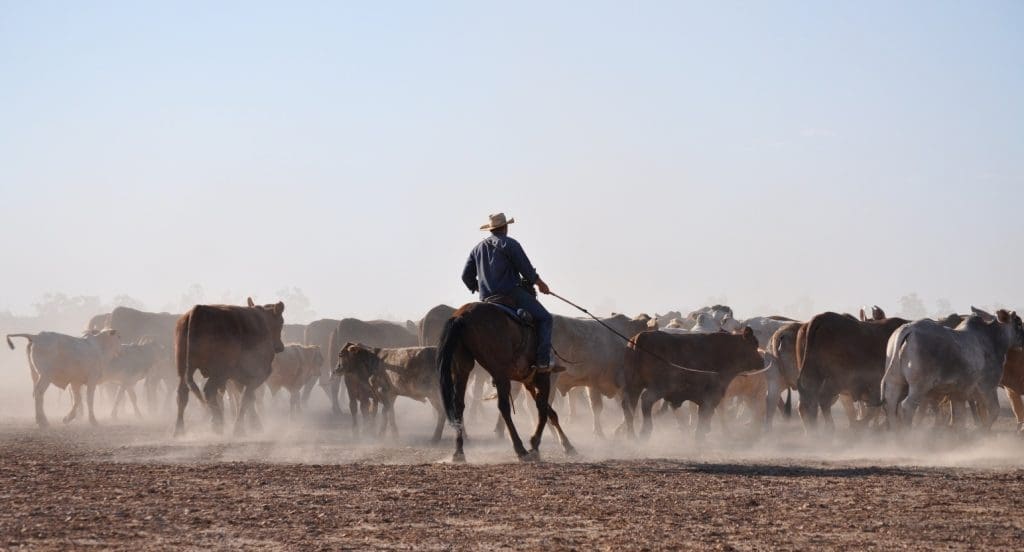
WHILE the red meat industry will inevitably suffer impacts from COVID-19, the underlying global demand drivers for beef and sheepmeat still exist, and will serve to underpin the industry, Meat & Livestock Australia managing director Jason Strong says.
Speaking to Beef Central on Friday, Mr Strong said the massive deficit that exists in global protein production – influenced heavily by last year’s African Swine Fever outbreak in China and other countries – would continue to support the fortunes of Australia’s red meat and livestock industries.
Impacts from COVID-19 were being seen in areas like logistics problems and sudden, often unexpected movements in consumer demand this year, but fundamentally, beef and lamb remained in good shape, he said.
“African Swine Fever has taken 40 million tonnes of protein out of the world food pipeline. The increase in affluence in developing countries over the next three to five years, and the protein deficit that exists are still there. While the rate of increase in affluence in developing countries will likely take a hit from COVID-19, the bigger hits will be seen in developed economies like the US,” Mr Strong said.

Jason Strong
Once countries started coming ‘out the other side’ after COVID-19 lockdowns, it was likely that the speed and extent of the recovery would be pronounced, because all the other demand factors remained in place.
“The next few months are going to be wild for many in the red meat supply chain, with limitations on what people can do and where they can go, but after that, we have all these factors that are setting the industry up well for the future,” he said.
“From the supply side, Australia has had its most significant rain event in years, if not decades, which will start to push herd rebuild in the right direction.
The Federal government and industry organisations were working extremely hard to manage the challenges surrounding COVID-19 challenges, and keep the supply chain moving, Mr Strong said.
Logistics and port access – principally in importing countries, rather than in Australia – loomed as one challenge.
“But Australia is not a one-for-one comparison with many of those countries. The Australian government has been a lot more proactive than some others in areas like logistics and freight,” he said.
“Getting access to ports is not currently the problem, it’s more about access to inbound containers, but the freight companies will find solutions to those things.”
Mr Strong said there were a lot of industry concerns around staff, and what would happen if a large operation in the red meat supply chain got a positive coronavirus test result.
“Part of the challenge we currently have is that there is quite a bit of presumption going on – some people are jumping at shadows. A positive detection among staff at a meat plant, for example, does not necessarily mean the plant has to shut down. There is nothing in any of the regulations or standards that says that would have to happen.”
Mr Strong said the approach taken to workplace health and safety within the mining industry could provide valuable guidance for the beef industry.
“The mining industry, to a large extent, deals with this quantum of risk assessment every day. They have a very disciplined risk management approach, and beef can take some good lessons from this,” he suggested.
Mr Strong said those countries that had ‘gone hard’ at coronavirus in its early stages – like Singapore, South Korea and Taiwan – had lined themselves up for four to six weeks of economic pain, but were then heading towards recovery.
“In contrast, those countries that are trying to ‘manage’ the infection less aggressively over a longer period – perhaps six months – run the risk of ‘going into the dark ages’,” he said.
Many business owners could afford to shut their businesses for perhaps four to six weeks, but a six-month closure for many would be fatal, he said.
Domestic, export market outlook
In red meat market performance, Mr Strong noted the contrasts in fortunes that had emerged in the domestic beef market between food service and retail over the past two months, since COVID-19 impact had emerged. While retail sales have boomed sine March, food service restaurants and hotels were now closed, or doing takeaways only.
This had pushed consumers towards everyday items like mince, but had impacted other items popular in food service.
“But there’s now less distinction between product used on the domestic market, and what is sold into export,” Mr Strong said.
“Twenty years ago, domestic beef was from lighter animals, mostly grassfed. Now, a lot of it comes through much more sophisticated supply chains, heavier carcase weights, and largely shortfed, in some way. So much of Australia’s beef business is now parts-based anyway, with some cuts used in export and others in domestic. But the two can now much more easily interchange,” he said.
 Beef Central will cover off on more comments from Jason Strong about recent domestic market performance in a separate article tomorrow.
Beef Central will cover off on more comments from Jason Strong about recent domestic market performance in a separate article tomorrow.
In export beef destinations, he acknowledged that there was signs of life in the China beef market again – especially for chilled meat.
“The Chinese are pushing now to get back to work and normal routines, having emerged from their earlier shutdown period. MLA’s own Shanghai office has been back at work for a week or two, and while there are still varying reports coming back about the state of Chinese ports, freight is moving, and the market is recovering,” he said.
There could well be a period of catch-up, after the void that was left earlier in trade, Mr Strong said.
Other North Asian markets like Japan and Korea also seemed to be managing the COVID-19 challenge well, and beef trade remained sound.
Clean & green reputation
“Out of this COVID-19 issue, we are seeing some incredibly positive information coming out about the perception of Australian product in the international market,” Mr Strong said.
“The view is that consumers under challenge from the virus threat are gravitating more strongly towards products they identify as clean & green. While it is still in its early stages, we are seeing some consumer data coming in which supports that very strongly – particularly in China. We think that is going to be very positive in the months ahead, for Australian red meat.”
In the US, consumers are taking actions similar to those in Australia, seeking to stockpile products like ground beef for future use.
Change in buying habits and preferences?
Beef Central asked Mr Strong whether the changes in consumer habits now being seen, such as more at-home food preparation, and purchasing food online, were likely to remain after the COVID-19 threat has cleared.
“I don’t anticipate that we will see fundamental changes like that,” he said.
“These things happen progressively. The market may see some increased online purchasing, but it’s likely, after a lengthy period where consumers have only eaten at home, that there will be a huge response in food service restaurant, pub and club dining after this is all over,” he said.
“Remember, all of these social changes that we’ve seen have been forced on people – it’s not as if consumers suddenly all decided they did not want to eat out any more. It’s all about staying home so somebody does not die.”
“As much as most people enjoy sitting down for a meal at home with their family, when this all clears, the first thing they will want to do is not do this, but go out to eat.”
“But COVID-19 may also mean that more consumers become familiar with alternate channels, such as buying fresh beef online, rather than at the supermarket. That will auger well for segments like online home-delivery – it will become more efficient, and a larger percentage of the population may be prepared to use it.”
“But I don’t know that COVID-19 lock-downs will stimulate a fundamental shift in the way people want to eat.”
“There will inevitably be some disruption and losses of food service restaurant and café operators – it is currently a very difficult space – but for those who last the distance, food service will pick up where it left off.”
Cattle prices
Asked about the response in cattle markets since COVID-19 took hold, Mr Strong said while there would be inevitable disruptions, ultimately it would be positive, with the strong outlook that lay ahead for the industry.
“At the moment, it is still largely numbers that are driving the big cattle price shifts that have been seen. We do tend to end up allocating responsibility for such market movements to things like the virus. But maybe this is just the numbers that were going to turn up anyway, a few weeks after a big rain event.”
“Irrespective of the impact of the virus, it was always likely that a heap of cattle would come forward over the past few weeks. Yes, the price has come back, but as humans, we tend to re-set our horizons in terms of ‘massive decreases’ or ‘massive increases’ pretty quick.
“Here we are with an Eastern States Young Cattle Indicator that has dropped all the way back to 704c/kg (discontinued temporarily last week due to market reporting challenges), but 60 days ago, it was at 500c/kg. Similarly, feeder steers have definitely come back in value, but they’re still pretty good, in historic terms.”
Similarly, 90CL manufacturing beef prices had come off the huge highs seen towards the end of 2019.
“But the market is still operating at levels where we were last year – well above the five-year average,” Mr Strong said.
“It’s very easy to forget that over the last two years, we’ve had the demonstration of the re-set in the industry structure – two of the worst years ever seen from a weather viewpoint, yet all of our industry indicators were at, or above five-year averages.”
“We’ve never seen anything like that before. Traditionally, drought has delivered very low cattle prices due to excess turnoff, but that did not happen last year due firstly to the strength of global beef demand, but also to the sophistication of our supply chains.”
“There’s more work to do yet, but there are now more people in the supply chain that are better connected, and reliant on each other to collectively respond to that underlying global demand for red meat that’s being seen.”
“As an industry, we have fantastic opportunities in front of us. Yes, there are some big risks and challenges evident at the moment, and it’s going to be a crazy time with some volatility and disruption for a few months. But the big drivers still haven’t gone away,” Mr Strong said.
“The next three to five years, Australian red meat has an opportunity to reset our industry and the supply chains it serves, if we can line up together to supply into this global demand.”
“Global demand for protein keeps going up each year, currently 75-80 million tonnes. But Australia only exports around a million tonnes – we just need to find the customers with the most money, who appreciate the qualities that Australian beef and lamb has to offer, and get ourselves in front of them.”
- Below are two new global market outlook reports issued by MLA late last week:
- Red meat at risk of global slowdown
- Shifting global demand creating beef carcase imbalance



It’s good to hear insights and positive talk, but there is also a requirement for action. From recent experience MLA’s Integrity Systems (inc NLIS) slow for authorities to data mine and would not pass the’ Cow Catcher’ simulation ran years ago . Be it Foot and Mouth Disease, a Food safety scare or other biological event, we need a better system or we are at severe risk of Beef going the same way as China did with ASF.